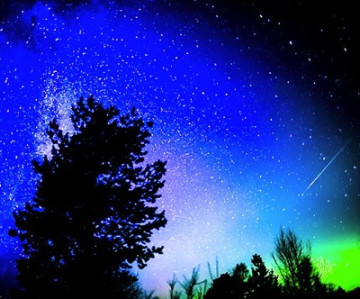October Meteor Shower Update
Saturday, October 27, 2012
How were this month's Orionid meteor showers? Astronomy contributor David Huestis had his eyes to the skies.
I set my alarm for just before 3:00am and soon stepped out onto my back porch. Immediately I could see the Winter Circle, a large stellar asterism that encompasses six constellations.
In fact, the Winter Circle contains seven of the 23 brightest stars we can see from northern hemisphere skies. Starting from the brightest star we can see in the sky (besides the Sun of course) and touring clockwise we find Sirius (Canis Major, the big dog), Procyon (Canis Minor, the little dog), Pollux and Castor (Gemini, the twins), Capella (Auriga, the charioteer), Aldebaran (Taurus, the bull), and Rigel (Orion, the hunter). We now complete the tour of the Winter Circle by swinging back to Sirius. But wait, there’s one more star that although it resides well within the Circle, it is considered part of the asterism. And that’s Betelgeuse.
GET THE LATEST BREAKING NEWS HERE -- SIGN UP FOR GOLOCAL FREE DAILY EBLASTAlso, there was another bright object to the east (right) of the Hyades open cluster containing Aldebaran. That was Jupiter. Jupiter outshone all of the stars, even Sirius! The sky was very transparent and the stars were not shimmering. The temperature was around 47 degrees with no wind. I quickly sat down in a porch chair to begin my observing run.
It took about five minutes before I saw my first Orionid meteor. I had hoped the number of meteors would increase as the morning progressed. Unfortunately, individual members of this display were few and far between.
During a two-hour span I only counted a total of 21 meteors. A few weren’t even Orionids. All of them were white. And many of the Orionids were fairly dim ones that I’m sure were not even seen by folks who observed from locations plagued by light pollution. Only three were bright enough to leave dust trains that lasted only about one second each. One bright meteor, blazing east to west, passed just to the north of Jupiter.
Around 4:30am I caught a glimpse of brilliant Venus low in the east through the now less leafy trees. Regulus, Leo’s brightest star that anchors the backwards question mark asterism, also rose above my tree-line at about the same time.
It is always so tranquil just gazing at the sky and pondering if out there on some exosolar world an alien stargazer is doing likewise. Though the number of meteors was disappointing, luckily there was just barely enough activity to keep me from falling asleep. Despite the clear and moonless skies we certainly did not experience a peak rate of 20 shooting stars per hour from this location.
I can only hope the activity picked up between 5:00am and dawn’s early light for those observers who decided to watch later than I did.
Related Articles
- Meteor Showers + More Predictions for 2012
- October Meteor Showers
- Perseid Meteor Shower Peaks in August
- NEW: Perseid Meteor Shower Starts Tonight
- Meteor Showers This Weekend



